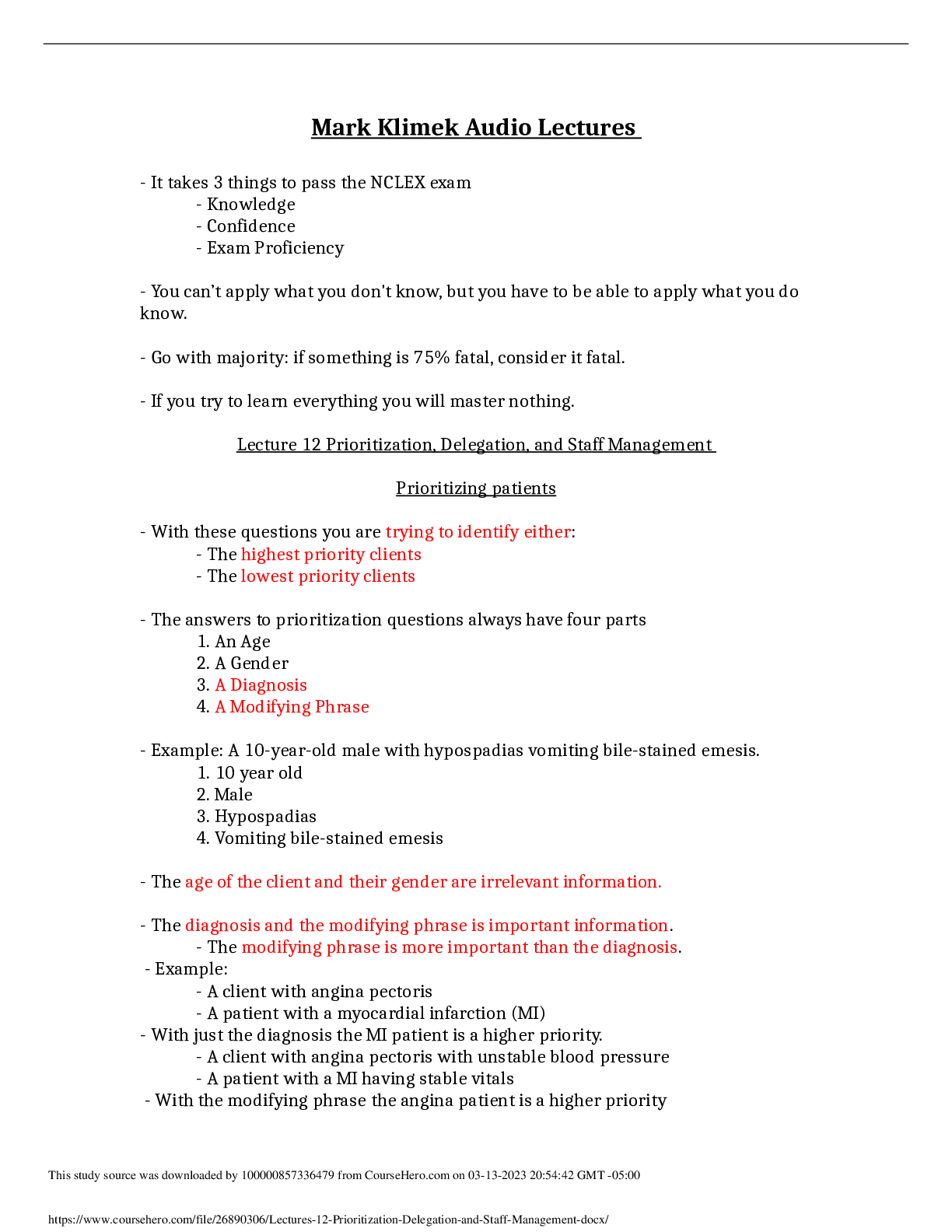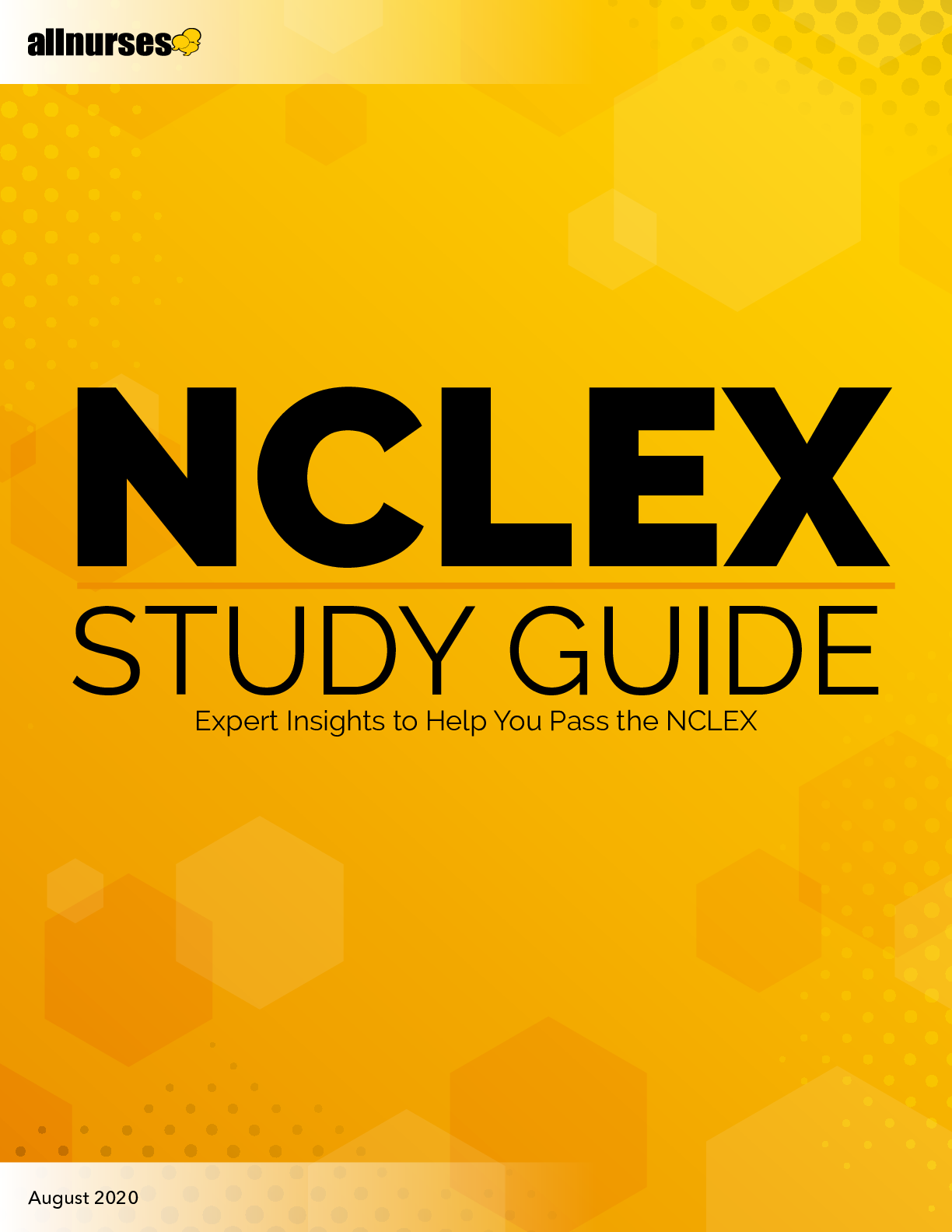NCLEX-PN Test prep questions. And answers, 2022. Graded A+
Document Content and Description Below
NCLEX-PN Test prep questions. And answers, 2022. Graded A+ Select the member of the healthcare team that is paired with one of the main functions of this team member. A. Occupational therapist: ... Gait exercises B. Physical therapist: The provision of assistive devices to facilitate the activities of daily living C. Speech and language therapist: The treatment of swallowing disorders D. Case manager: Ordering medications and treatments - ✔✔*Correct Response: C* Speech and language therapists assess and treat patients with a swallowing disorder; they also assess and treat patients with speech and communication problems as often occurs after a cerebrovascular accident, or stroke. *Occupational therapists assist patients with their activities of daily living and they also provide patients with assistive devices to facilitate eating and dressing. *Physical therapists perform rehabilitation and restorative care including help with ambulation and balance/gait exercises. *Lastly, case managers coordinate care along the continuum of care and they manage insurance reimbursements. The recommended daily caloric intake for sedentary older men, active adult women and children is: A. 2400 calories B. 1600 calories C. 2800 calories D. 2000 calories - ✔✔*Correct Response: D* Sedentary older men, active adult women and children should all have 6 ounces of grains, 2½ cups of vegetables, 2 cups of fruits, and 3 cups of milk to help make up their 2000 calorie requirement. Sedentary adolescents require 2400 calories, sedentary women and children require 1600 calories and active adolescents need 2800 calories daily. Ill health, malnutrition, and wasting as a result of chronic disease are all associated with: A. Surgical asepsis B. Catabolism C. Cachexia D. Venous stasis - ✔✔*Correct Response: C* Ill health, malnutrition, and wasting as a result of chronic disease are all associated with cachexia. Cachexia can also result from dehiscence of a surgical incision or rupture of wound closure. *Surgical asepsis refers to using a sterile technique to protect against infection before, during, and after surgery. The breakdown of tissue, especially after severe trauma or crush injuries is known as *catabolism. *Venous stasis is a disorder related to pooling of blood in a vein of the body; venous stasis typically occurs in the lower extremities and it is one of the many hazards, or complications, of immobilization. Select all the possible opportunistic infections that adversely affect HIV/AIDS infected patients: A. Visual losses B. Kaposi's sarcoma C. Wilms' sarcoma D. Tuberculosis E. Peripheral neuropathy F. Toxoplasma gondii - ✔✔*Correct Response: B, D, F* Kaposi's sarcoma, tuberculosis, toxoplasma gondii, mycobacterium avium, herpes simplex, histoplasmosis and salmonella infections are HIV/AIDS associated opportunistic infections. *Although many affected patients can experience blindness and peripheral neuropathy, these disorders result from impaired nervous system damage rather than an infection. *Lastly, Wilms' tumor (sarcoma) is a pediatric form of kidney cancer and it is neither an infection nor something that typically affects the patient with HIV/AIDS What can help reduce a patient's anxiety and postsurgical pain? A. Preoperative teaching B. Preoperative checklist C. Psychological counseling D. Preoperative medication - ✔✔*Correct Response: A* Patient teaching before surgery not only helps to reduce a patient's anxiety and postsurgical pain but it also decreases the amount of anesthesia needed and a lack of anxiety additionally speeds up wound healing. Preoperative checklists are a form of nursing documentation that is used to guide and document the care of the patient before surgery. Psychological counseling is typically NOT necessary except under highly unusual circumstances and preoperative medication can decrease the amount of anesthetic needed and respiratory tract secretions but it does not help with postoperative pain. Which disease decreases the metabolic rate? A. Cancer B. Hypothyroidism C. Chronic obstructive pulmonary disease D. Cardiac failure - ✔✔Answer: B- hypothyroidism. When caring for an infant during cardiac arrest, which pulse must be palpated to determine cardiac function? A. Carotid B. Brachial C. Pedal D. Radial - ✔✔Brachial (B). The patient after surgery should be sitting when deep breathing and coughing because this position: A. Is physically more comfortable for the patient B. Helps the patient to support their incision with a pillow C. Loosens respiratory secretions D. Allows the patient to observe their area and relax - ✔✔Supports their incision! (B) Which procedures necessitate the use of surgical asepsis techniques? Select all that apply. A. Intramuscular medication administration B. Central line intravenous medication administration C. Donning gloves in the operating room D. Neonatal bathing E. Foley catheter insertion F. Emptying a urinary drainage bag - ✔✔B, C, F. What is the ultimate purpose and goal of performance improvement activities? A.To increase efficiency B.To contain costs C.To improve processes D.To improve policies - ✔✔C. Even if you don't know the information in the question, be sure to use common sense & process of elimination. Example: "goal performance *IMPROVEMENT* activities". The key word here is improvement. You can instantly remove A & B. Now, read further into the question. Your next hint is going to be the word performance. so, performance improvement matches with improve process the best. The primary difference between practical nursing licensure and a nursing certification in an area of practice is that nursing licensure is: A. Insures competency and a nursing certification validates years of experience. B. Mandated by the American Nurses Association and a nursing certification are not. C. Is legally mandated by the states and a nursing certification is not. D. Renewed every two years and a nursing certification is renewed every five years. - ✔✔C. What intervention is the best to relieve constipation during pregnancy? A.Increasing the consumption of fruits and vegetables B.Taking a mild over-the-counter laxative C.Lying flat on back when sleeping D>Reduction of iron intake by half or more - ✔✔A- remember! DARK, LEAFY GREEN VEGTABLES IS ALMOST ALWAYS THE RIGHT ANSWER! Process of elimination- B= medication is always the last option (you don't want them to become dependent.) C= doesn't really have anything to do with bowel movements. D= You never want to decrease your iron intake during pregnancy! You are the LPN working on 2 east with adult medical surgical patients. Your unit has been instructed to perform a horizontal evacuation of your patients because there is a fire on 1 east. Where will you evacuate your patients to? A. 3 west B. 3 east. C. 2 west D. 1 west - ✔✔C- think logically. The number usually indicates the floor number. So use your head! pick out the word horizontal, which means side to side. (long ways, hot dog, etc.) Now, think of a compass. North and south are vertical on a compass. East and West are horizontal. Process of elimination, a-different floor. b-different floor, d-different floor.... Which electrolyte is essential for enzyme and neurochemical activities? A.Chloride B.Magnesium C.Potassium D.Phosphate - ✔✔B, magnesium. Number the choices below to reflect the correct sequence for using a fire extinguisher: A. Aim at the base of the fire B. Squeeze the handle C. Sweep back and forth D. Pull the pin - ✔✔remember- PASS. Pull, Aim, Squeeze, Sweep!!! D, A, B, C. As you are working you suspect that another licensed practical nurse is verbally and physically abusing a patient. What is the first thing that you will do? A.Nothing because you are not certain that it is occurring B.Nothing because you only suspect the abuse C.Call the police or the security department D.Report your suspicions to the charge nurse - ✔✔D, process of elimination. instantly get rid of A & B. DON'T be a bystander! Always do something, big or small. And then get rid of C, you don't want to jump the gun and possibly make false accusations. Which of the following is the World Health Organization's (WHO) definition of health? A. The absence of all illness and disease B. The absence of any comorbidities C. A holistic state of wellbeing D. A use of health promotion activities - ✔✔C, full definition: Health is a state of complete physical, mental and social well-being and not merely the absence of disease or infirmity. Which nursing theorist believes that most patients are capable of performing self care? A. Dorothea Orem B. Madeleine Leininger C. Martha Rogers D. Sister Callista Roy - ✔✔A. What element is minimally assessed during a basic prenatal physical examination? A. Palpation and auscultation of the abdomen B. Examination of the anus and rectum C. Urinalysis for glucose, protein and ketones D. Visual assessment of cervix and vagina - ✔✔C, think logically. Although UA's are always done on a pregnant woman, the question being asked is focusing on a BASIC PHYSICAL EXAMINATION. First key word is basic. Second, is going to be the physical aspect of the exam. Think back to physical assessments. You didn't collect UA's, draw blood, or do anything other than what is considered "basic." All of the other choices (other than C) are very basic pieces to an examination. A positive over-the-counter pregnancy test is considered a: A. Possible sign of pregnancy. B. Presumptive sign of pregnancy. C. Probable sign of pregnancy. D. Positive sign of pregnancy. - ✔✔C. Select all of the signs and symptoms of hyperthyroidism. A. Cool skin B. Thickened bodily hair C. Heat intolerance D. Constipation E. Insomnia F. Increased appetite G. Palpitations - ✔✔C, E, F, G. HYPER vs HYPO: Hyper- hot, skinny, increased appetite +weight loss, trouble sleeping, not tired, palpitations. Hypo- cold, overweight, lesser appetite, increased tiredness/sleep. During which phase of the nursing process does data get collected and validated with the patient and/or family members by the nurse? A. The implementation phase B. The assessment phase C. The evaluation phase D. The planning phase - ✔✔B- data collection = assessment. remember ADPIE. Which of the following is the best worded expected outcome? A. "The nurse will provide for adequate hydration" B. "The nurse will insure that the patient is safe" C. "The patient will cough and deep breathe every two hours" D. "The patient will value health" - ✔✔C. Provides the most information, worded the best. What is a major difference between a problem oriented medical record and a source oriented medical record? A. The problem oriented medical system has a centralized part of the chart for interdisciplinary progress notes and the source oriented medical record has separate areas for each profession's progress notes. B. The problem oriented medical system consists of narrative progress notes and the source oriented medical record uses SOAP. C. The source oriented medical system uses charting by exception and the source oriented medical record system does not. D. The source oriented medical system has a centralized part of the chart for interdisciplinary progress notes and the problem oriented medical record has separate areas for each profession's progress notes. - ✔✔A. Source VS. Problem medical records: Source= one in which each healthcare group keeps data on its own separate form. Sections designed for nurses, physicians, lab, x-ray, etc. Disadvantages include: Fragmented data -- making it difficult to track problems chronologically with input from different groups of professionals. Advantages include: Each discipline can easily find and chart pertinent data. Problem= Organized around a patient's problems rather than around sources of information. Advantages include: Entire healthcare team works together in identifying a master list of patient problems and contributes collaboratively to the plan of care. Which of the following are necessary elements of malpractice? Select all that apply. A. A breach of duty B. An intentional act C. A unintentional act D. Foreseeability E. Patient harm F. Causation - ✔✔A, D, E, F. -Can be intentional OR unintentional. Select the following fire emergency interventions in correct sequential order. A. Pull the fire alarm. B. Contain the fire. C. Rescue patients in danger. D. Extinguish the fire. - ✔✔C,A, B, D. Remember RACE! Rescue, Alarm, Contain, Extinguish.! After your patient has been told that they have Cushing's syndrome, the patient asks you what Cushing's syndrome is. How would you respond to this patient's question? A. "Cushing's syndrome is a type of irritable bowel syndrome." B. "Cushing's syndrome is a disorder of the adrenal gland." C. "Cushing's syndrome often occurs among patients who are getting radiation therapy." D. "Cushing's syndrome often occurs among [Show More]
Last updated: 3 years ago
Preview 1 out of 32 pages

Buy this document to get the full access instantly
Instant Download Access after purchase
Buy NowInstant download
We Accept:

Reviews( 0 )
$8.00
Can't find what you want? Try our AI powered Search
Document information
Connected school, study & course
About the document
Uploaded On
Aug 26, 2022
Number of pages
32
Written in
All
Seller

Reviews Received
Additional information
This document has been written for:
Uploaded
Aug 26, 2022
Downloads
0
Views
159
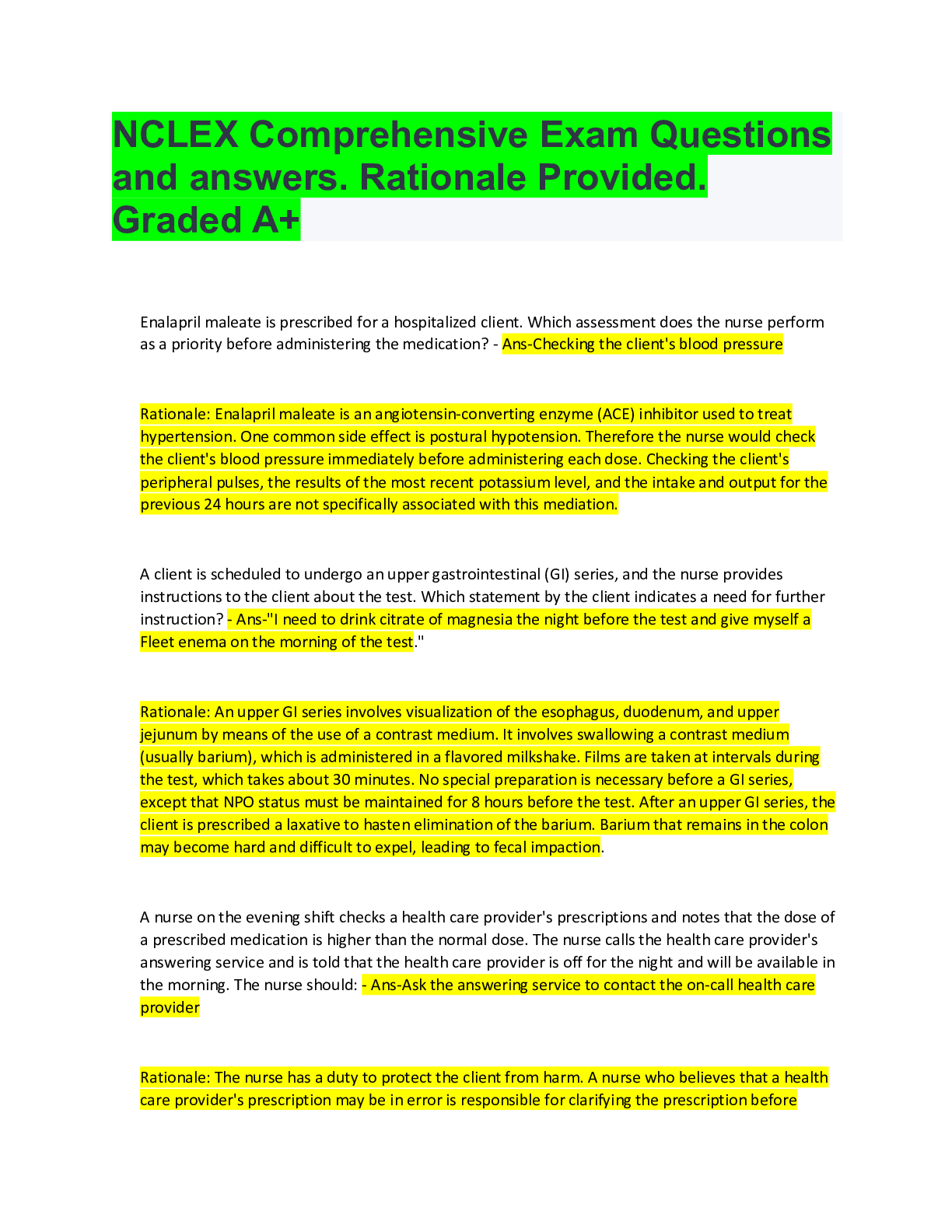
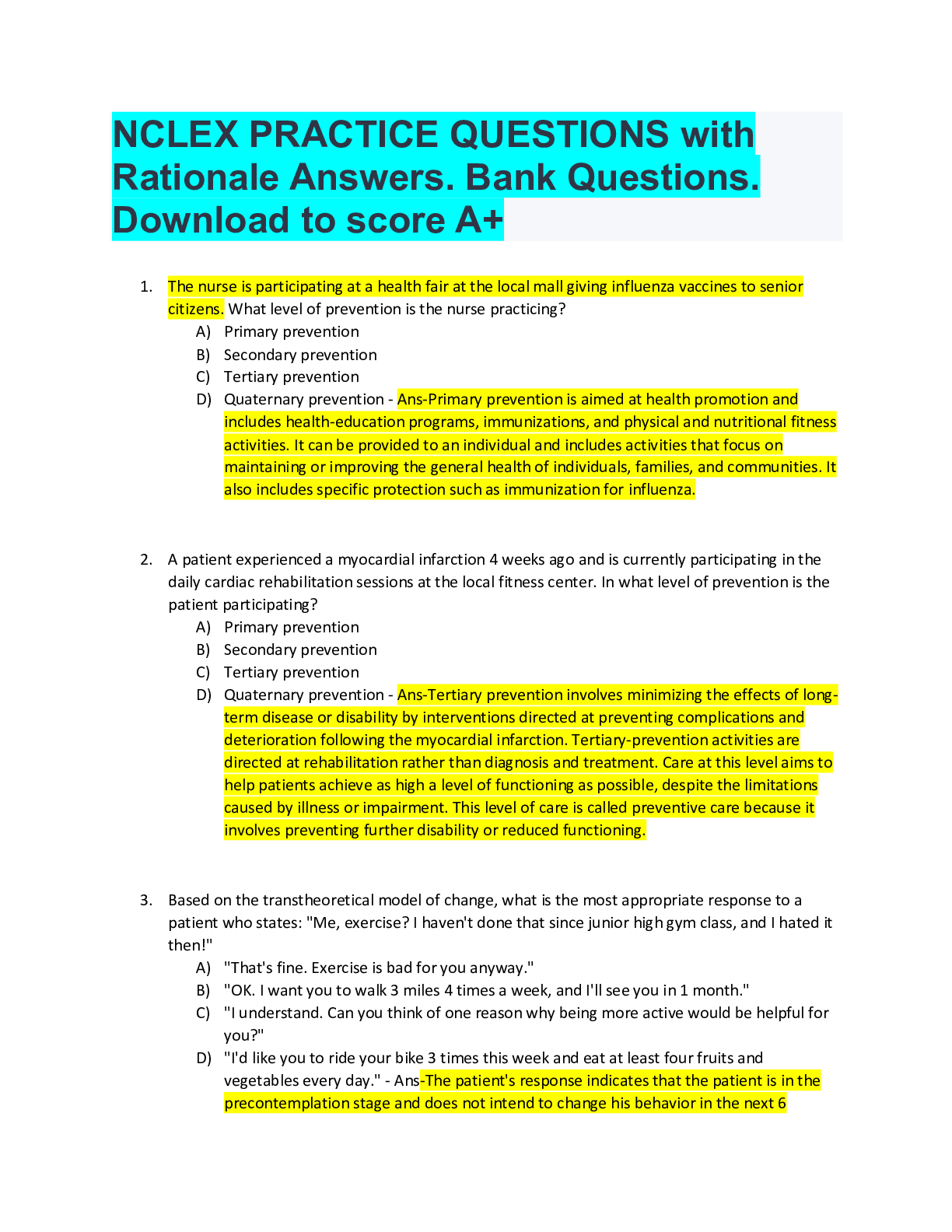




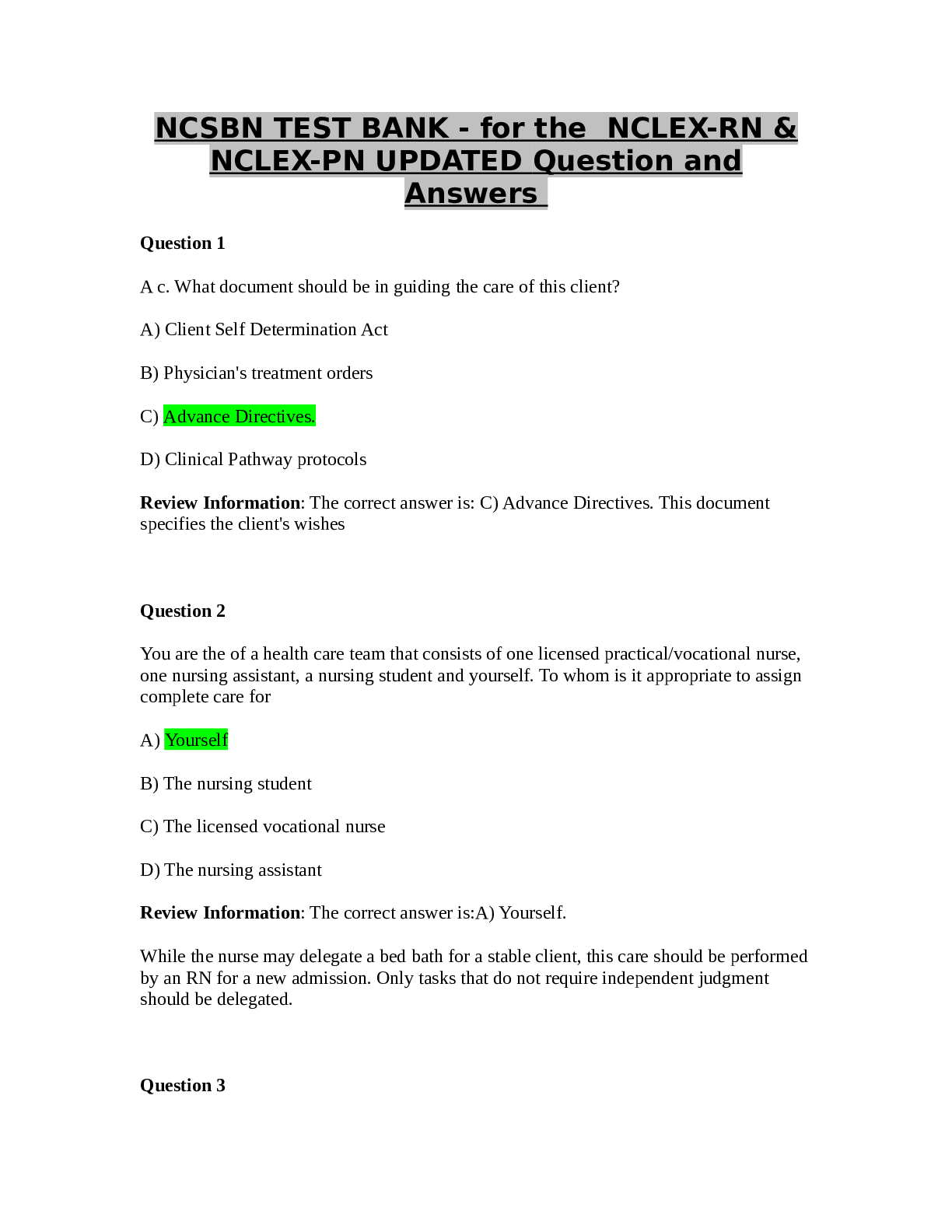

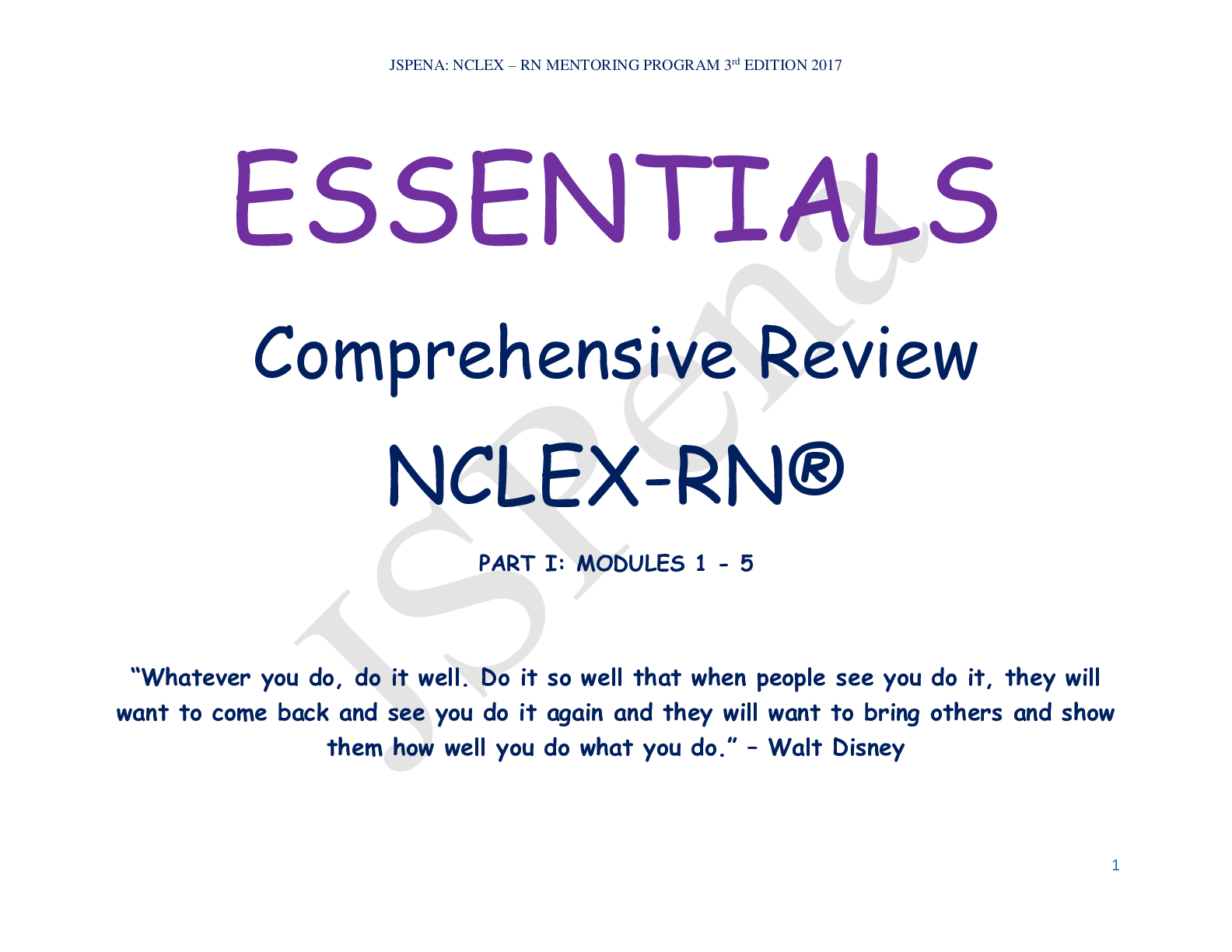




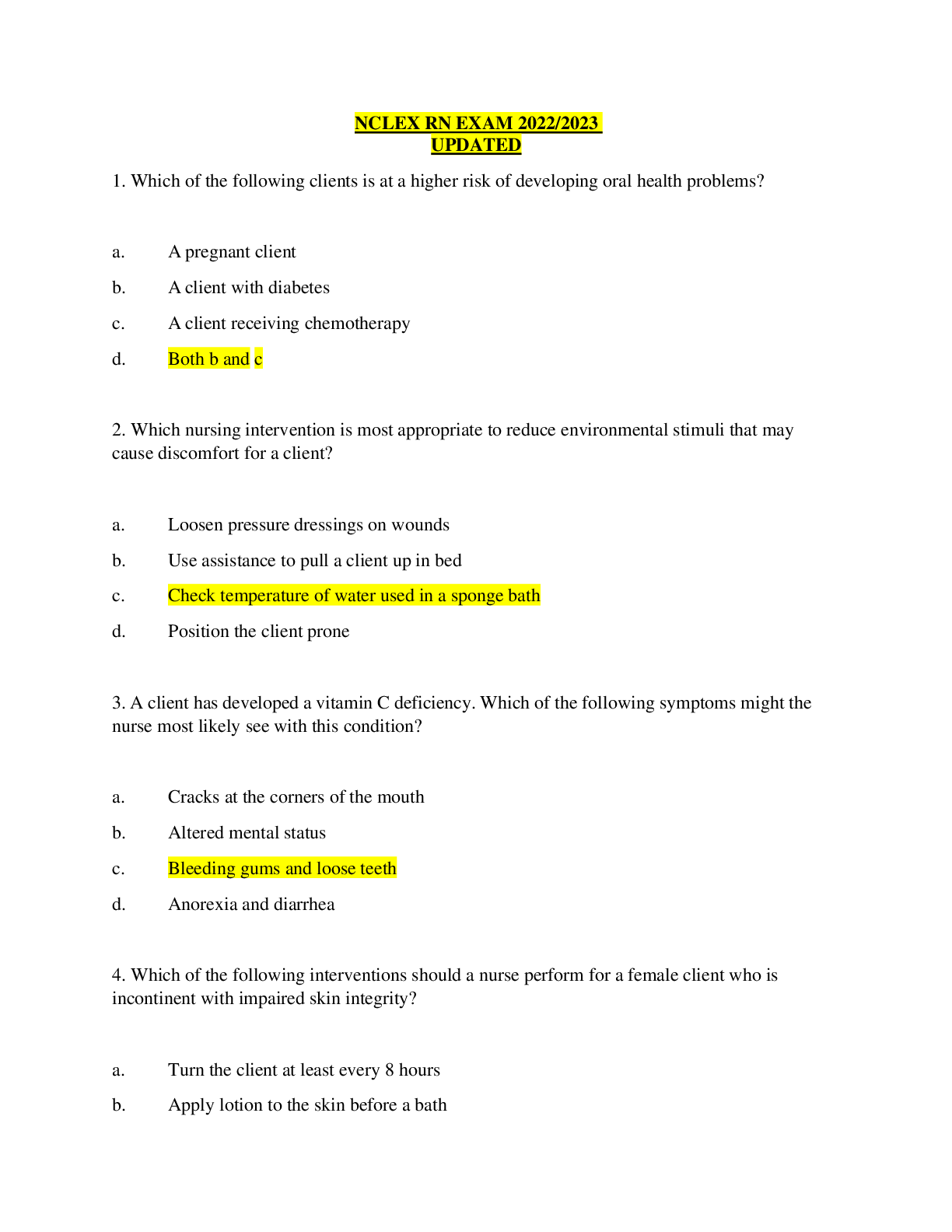
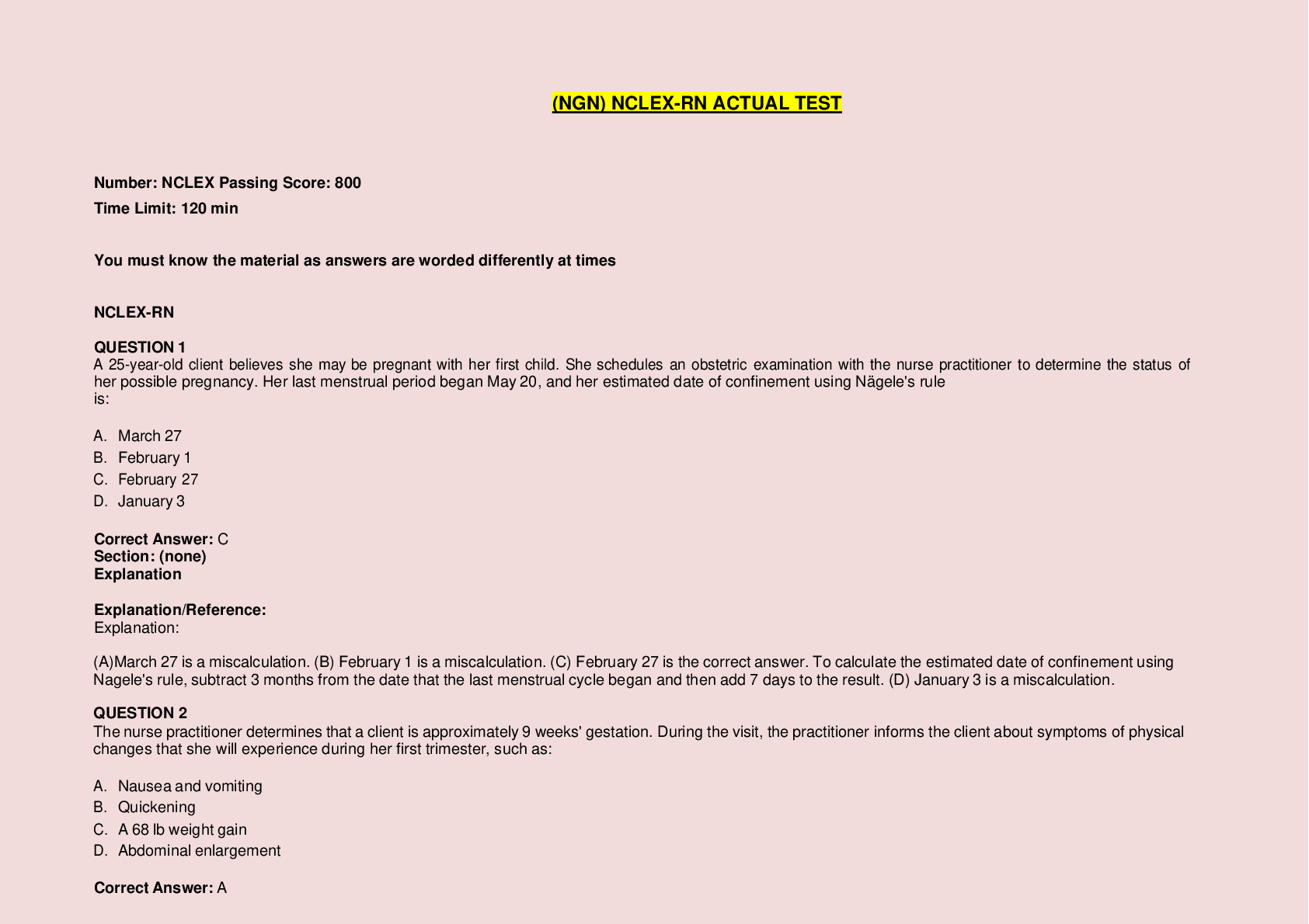
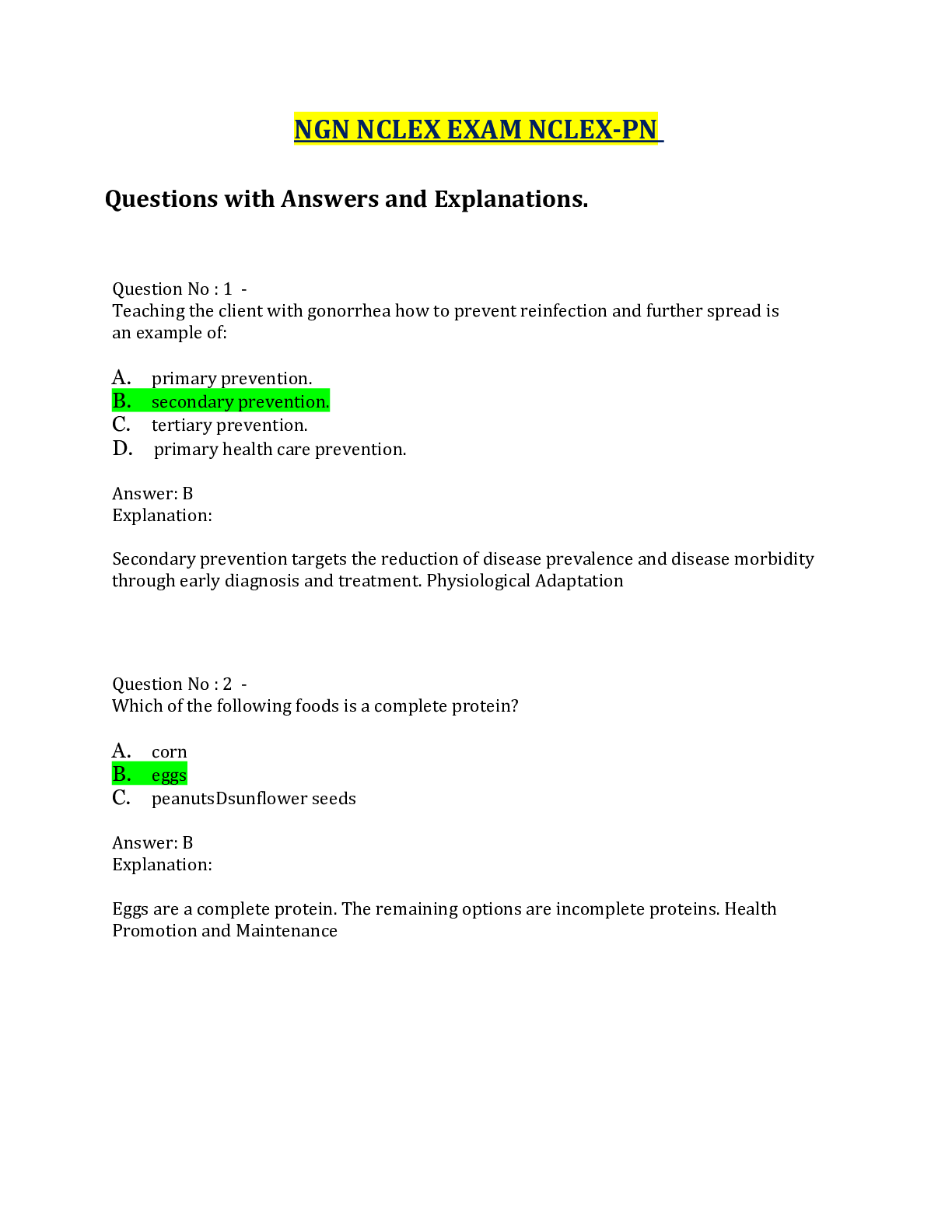

 JN21.png)
